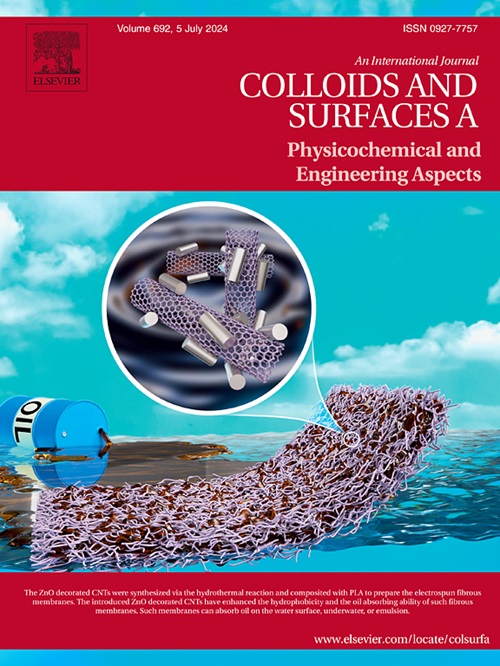Redox-active cerium dioxide nanoparticles for mitigating anthracene contamination: Promising solution to polycyclic aromatic hydrocarbon remediation in stormwater-affected soils
IF 4.9
2区 化学
Q2 CHEMISTRY, PHYSICAL
Colloids and Surfaces A: Physicochemical and Engineering Aspects
Pub Date : 2024-10-31
DOI:10.1016/j.colsurfa.2024.135657
引用次数: 0
Abstract
Due to the pressing environmental issue of polycyclic aromatic hydrocarbon (PAH) contamination in stormwater, top surface soil amendment by rare-earth-based nanoparticles was investigated as an effective remediation strategy. Here, the amendment of cerium dioxide (CeO2) nanoparticles (CeO2-NPs) into topsoil were studied to understand their role in mitigating anthracene contamination. Leveraging the redox activity of CeO2-NPs, this research demonstrates their capability to adsorb/degrade anthracene, thereby reducing its bioavailability and mobility within the soil. X-ray photoelectron spectroscopy (XPS) and Energy Dispersive X-ray Spectroscopy (EDS) analyses confirmed the homogeneous distribution of CeO2-NPs and revealed the altered chemical states of carbon, indicative of interaction with anthracene and the soil matrix. Further adsorption studies and soil column tests of four concentrations of anthracene (0, 5, 10, 15 mg/L) revealed their adsorption onto CeO2-NPs. Further, size distribution, zeta potentials, and TEM images documented the efficiency of this strategy by over 60 %. The role of soil organic matter in the presence of anthracene was further investigated to understand their reciprocal impact on the physiochemical properties of CeO2-NPs. We extended this analysis by incorporating genomics-based approaches, assessing alterations in community taxonomic structure and function through 16S rDNA profiling and heatmap of microbial diversity as affected by NPs or anthracene. This study enhances our understanding of nanotechnology's potential for environmental remediation of contaminated stormwater run-off.
用于减轻蒽污染的氧化还原活性二氧化铈纳米粒子:受暴雨影响土壤中多环芳烃修复的可行解决方案
由于雨水中的多环芳烃(PAH)污染是一个紧迫的环境问题,研究人员将稀土基纳米粒子作为一种有效的修复策略对表层土壤进行改良。本文研究了将二氧化铈(CeO2)纳米粒子(CeO2-NPs)添加到表层土壤中的方法,以了解其在减轻蒽污染方面的作用。这项研究利用 CeO2-NPs 的氧化还原活性,证明了它们吸附/降解蒽的能力,从而降低了蒽在土壤中的生物利用率和流动性。X 射线光电子能谱 (XPS) 和能量色散 X 射线能谱 (EDS) 分析证实了 CeO2-NPs 的均匀分布,并揭示了碳化学状态的改变,表明了与蒽和土壤基质的相互作用。对四种浓度的蒽(0、5、10、15 毫克/升)进行的进一步吸附研究和土壤柱测试表明,蒽被 CeO2-NPs 所吸附。此外,粒度分布、ZETA 电位和 TEM 图像都证明这种策略的效率超过 60%。我们还进一步研究了土壤有机物在蒽存在时的作用,以了解它们对 CeO2-NPs 理化特性的相互影响。我们扩展了这一分析,纳入了基于基因组学的方法,通过 16S rDNA 图谱和受 NPs 或蒽影响的微生物多样性热图评估群落分类结构和功能的变化。这项研究加深了我们对纳米技术在受污染雨水径流环境修复方面潜力的理解。
本文章由计算机程序翻译,如有差异,请以英文原文为准。
求助全文
约1分钟内获得全文
求助全文
来源期刊
CiteScore
8.70
自引率
9.60%
发文量
2421
审稿时长
56 days
期刊介绍:
Colloids and Surfaces A: Physicochemical and Engineering Aspects is an international journal devoted to the science underlying applications of colloids and interfacial phenomena.
The journal aims at publishing high quality research papers featuring new materials or new insights into the role of colloid and interface science in (for example) food, energy, minerals processing, pharmaceuticals or the environment.

 求助内容:
求助内容: 应助结果提醒方式:
应助结果提醒方式:


